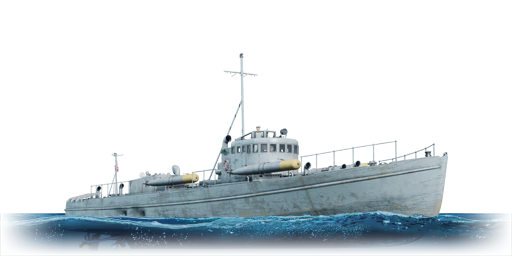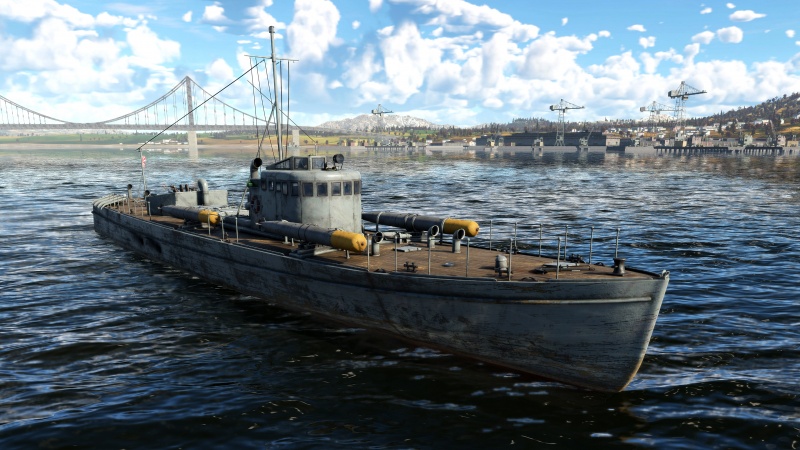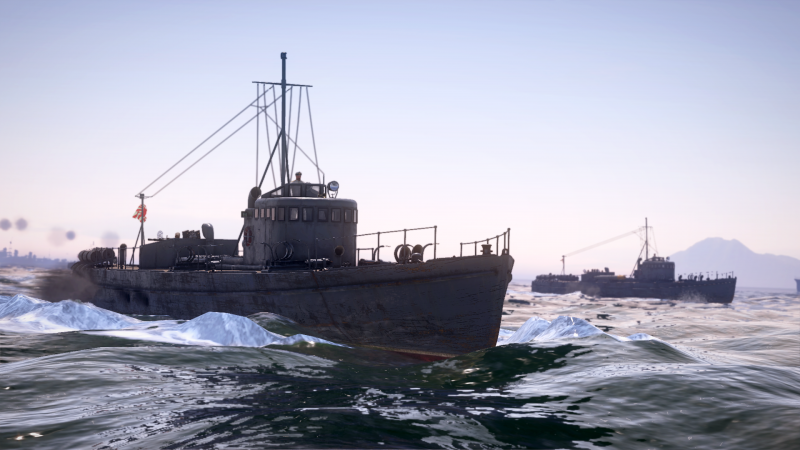Type T-51a
| This page is about the premium Japanese motor torpedo boat Type T-51a. For the regular version, see Type T-51b. |
Contents
Description
The Type T-51a (No. 10) was the first of a new Japanese patrol boat type, known as the Type A (Kō/甲) torpedo boat (Heavy Torpedo boat). Subsequent standard small-sized patrol boats would be classified under Type B (Otsu/乙). Called into production and influenced by German S-Boots in 1941, the Japanese attempted to upscale their patrol boats from the previous Type T-1 at 20 tons to 80 tons. However, due to relatively low advancements in shipbuilding materials, especially for patrol boats, the entire vessel was constructed from steel and wood instead of light alloy. Additionally, the armament exceeded the planned weight, reaching over 90 tons. This failure to meet expectations led to the development of the variant Type T-51b (No. 11 - 17).
It was introduced during Update "Danger Zone" as a reward for Battle Pass: Season VIII, "Field Testing". Despite failing to meet the planned weight, the vessel is still operational and can be effectively used in two roles: either utilising the four torpedoes against slower, larger vessels or ambushing light boats with its rear-mounted anti-air twin 25 mm emplacement.
General info
Survivability and armour
Talk about the vehicle's armour. Note the most well-defended and most vulnerable zones, e.g. the ammo magazine. Evaluate the composition of components and assemblies responsible for movement and manoeuvrability. Evaluate the survivability of the primary and secondary armaments separately. Don't forget to mention the size of the crew, which plays an important role in fleet mechanics. Save tips on preserving survivability for the "Usage in battles" section. If necessary, use a graphical template to show the most well-protected or most vulnerable points in the armour.
Mobility
Write about the ship's mobility. Evaluate its power and manoeuvrability, rudder rerouting speed, stopping speed at full tilt, with its maximum forward and reverse speed.
| Mobility Characteristics | |||
|---|---|---|---|
| Game Mode | Upgrade Status | Maximum Speed (km/h) | |
| Forward | Reverse | ||
| AB | |||
| Upgraded | 77 | 25 | |
| RB/SB | |||
| Upgraded | 55 | 18 | |
Modifications and economy
Armament
Primary armament
- Universal: HEF-T* · HEF · AP-T · HEI
- 25 mm APT belt: AP-T · AP-T · AP-T · HEF - Recommended against Russian armoured river boats.
- 25 mm HEIT belts: HEF-T* · HEI · HEI · HEI - Recommended belt
| Penetration statistics | |||||||
|---|---|---|---|---|---|---|---|
| Ammunition | Penetration @ 0° Angle of Attack (mm) | ||||||
| 10 m | 100 m | 500 m | 1,000 m | 1,500 m | 2,000 m | ||
| HEF-T* | 2 | 2 | 2 | 2 | 2 | 2 | |
| HEI | 2 | 2 | 2 | 2 | 2 | 2 | |
| HEF | 2 | 2 | 2 | 2 | 2 | 2 | |
| AP-T | 55 | 53 | 43 | 33 | 25 | 19 | |
| Shell details | ||||||||||||
|---|---|---|---|---|---|---|---|---|---|---|---|---|
| Ammunition | Velocity (m/s) |
Projectile mass (kg) |
Fuse delay (m) |
Fuse sensitivity (mm) |
Explosive mass (TNT equivalent) (g) |
Ricochet | ||||||
| 0% | 50% | 100% | ||||||||||
| HEF-T* | 900 | 0.24 | 0 | 0.1 | 8.5 | 79° | 80° | 81° | ||||
| HEI | 900 | 0.26 | 0 | 0.1 | 5.52 | 79° | 80° | 81° | ||||
| HEF | 900 | 0.25 | 0 | 0.1 | 23.93 | 79° | 80° | 81° | ||||
| AP-T | 900 | 0.28 | - | - | - | 47° | 60° | 65° | ||||
Additional armament
Describe the available additional armaments of the ship: depth charges, mines, torpedoes. Talk about their positions, available ammunition and launch features such as dead zones of torpedoes. If there is no additional armament, remove this section.
Usage in battles
The Type T-51a is one of the more tricky boats to use, with a very steep learning curve. The key defining feature of the boat is its rear-mounted gun, able to fire only in reverse, and thus has the option for a two particular playstyles:
Ambusher - Using hard cover, one can stick the stern out and use the gun with near-impunity, as the rear of the boat is a small target with little crew inside, enabling one to output a huge amount of damage before suffering any significant consequences. That said, enemy positioning has to be monitored at all times, as well as artillery strikes. Also, be careful with controlling speed and when fighting anything larger than a boat - the large-calibre guns found on destroyers can often blow the boat up even if hitting just the rear-most end of the hull. This tactic shines on the maps like African Gulf, Black Sea Port, Drowned City, Ireland Bay, or Vyborg Bay.
An alternative version of this approach is to bait enemy boats into following you, and then shooting directly back at them. Turning and then keeping the profile of the T-51a as narrow as possible is the tricky part, but the high-velocity 25 mm gun can typically sink them before they manage to inflict any significant damage back.
Torpedo boat - The T-51a has more torpedoes than any other Japanese boats of its rank or lower, and this opens some additional options, even if the torpedoes have a very short range of just 3 kilometres. Use of torpedoes is very opportunistic and typically best used against destroyers (most notably the Town and Clemson class) from behind hard cover. The key is to approach behind cover, select an enemy destroyer as a target and fire torpedoes at the alignment marker before you are directly visible to the enemy guns. Then either reverse or turn around, preferably without ever being in a direct line of fire. The large warhead of the onboard torpedoes will usually sink any destroyer with a single hit. This approach will benefit from a large amount of tall, hard cover on a way to the flanks of the destroyers, and a convenient escape routes, most notably on maps such as Japanese Port, North Port, or Norway.
Pros and cons
Pros:
- High velocity main gun with a short reload time can outdamage most peers, especially if they try to manoeuvre in a medium range
- A very narrow front and rear profile, low freeboard, especially on the rear-end
- Four torpedoes with a very large warhead that can instantly sink every ship around its BR
Cons:
- Main gun has a very inconvenient firing arc, including the steel shield on the edges of the horizontal arc, that lifts the gun up above the target, while the in-game indicator still shows the gun to be green to fire
- Offset of the gun compared to the aiming reticle along with frequent reloads make it very challenging to engage enemy aircraft
- Large side-profile makes it possible for some boats to kill the T-51a with a single barrage along the ship's length
- Very short-range torpedoes make it challenging to engage destroyers, especially in open waters
History
The Type Ko MTB (甲型魚雷艇, T-51) is a Japanese large MTB inspired by the German S-boots. This boat is separated into two group: No.10 class MTB (T-51a) and No.11 class MTB (T-51b).
After the completion of the No.1 class MTB (T-1), news about activity of the German Schnellboot (S-boot) from Europe reached the Imperial Japanese Navy (IJN). They started to copy the S-boot design, but they had only a simple sketch and one civilian motor boat owned by the Mitsui family built by Lürssen (a builder of S-boot). In that time, the Japanese did not have the experience to produce a wood-and-iron mixed large boat, so at first they built one prototype. ("Vessel No.600", later No.10 MTB)
The No.600 prototype was laid down in July 1942 by Yokohama Yacht Tsurumi factory and completed in November 1943. But because of the worsening of the war situation, they started mass-production the ship design before testing the prototype. Just afterwards, the Japanese receive official detailed drawings of 95-ft type S-boot. Basically, design of future T-51 and S-boat was similar, but there was much for the Japanese to learn.
In the designing of No.600, the Japanese simplified lots of part and material. Due to how well-crafted the S-boot design was, the simplification caused several problems. Though measures were taken to mitigate the problems, the vessel stability was not enough and so there were difficulties putting the ship into practical use.
No.600 was equipped with four Mark 71 Model 6 engines (water-cooled, 920 HP), which were a copy of the Italian MAS-451 MTB engines. There were two shafts, with two engines connected to one shaft by Vulkan coupling. However, this configuration caused an increase of weight and so the prototype exceeded the planned displacement of 84.2 tons, and instead reached 89.6 tons and so the maximum speed decreased. Because of this, the boat was redesigned into the No.11 class MTB, which eliminated the coupling and so each engine had their own shaft. With this, the single No.10 class design (No.600 prototype) was named the T-51a, with the redesigned No.11 class as the T-51b that would be the model for subsequent boat numbers.
Armaments was also redesigned between the two class. The T-51a had one 25 mm twin machine gun and four 45 cm torpedoes, while the T-51b had three 25 mm single machine guns and two torpedoes.
No.10 (T-51a), No.13 and No.16 were built at Yokohama Yacht Tsurumi factory, while the other boats were built by a new shipyard, Yokohama Yacht Choshi factory. A total of ten Type Ko MTBs were laid down, but only 8 boats were completed (No.10 - No.17). Construction of Type Ko was cancelled in August 1944. No.18 was planned to equip a small diesel engine, but it was not completed. The construction of Type Ko MTBs was delayed because the No.11 class MTBs need to resolve problem discovered during the testing of No.10 class MTB. Also the Mk.71 Mod.6 engines required advanced manufacturing technology and so production of engine was also delayed.
No.10 MTB was dispatched to Truk island just after completion, but a fire broke out and sank due to air raid. No.12 MTB was brought out from Choshi to Yokosuka to equip weapons, but just after that was completed, she sunk due to an electric motor spark that ignited the gasoline and subsequently exploded.
Other vessels was deployed to the Special Attack corps, but most of them did not experience the actual battle. Only one boat deployed at Habu port of Izu Oshima attacked an enemy submarine.
Also, No.16 MTB equip only two engine. She used space of other engines for hold and used for tender boat of other small MTBs and midget submarines at Kawadana Assault Corps.[1][2]
Media
- Skins
- Videos
See also
Links to articles on the War Thunder Wiki that you think will be useful for the reader, for example:
- reference to the series of the ship;
- links to approximate analogues of other nations and research trees.
External links
References
- ↑ Imamura Yoshinobu [今村好信], (2011) Story of Japanese Torpedo Boats [日本魚雷艇物語] (Kojin-sha, 2011) pp.55-60.
| Japan boats | |
|---|---|
| Motor torpedo boats | Type T-1 · Type T-14 · Type T-14 (mod. 1) · Type T-38 · Type T-51a · Type T-51b |
| PT-802 · PT-808 · PT-15 | |
| Motor gun boats | Ha-Go (mod. 1) · Type 4 (mod. 2) · Type 4 (Mod 4) |
| Asagao (YTE-01) · PG 02 | |
| Armoured gun boats | Soukou-Tei · Soukou-Tei No.4 |
| Gunboats | Chidori |
| Japan premium ships | |
|---|---|
| Motor torpedo boats | Type T-14 (mod. 1) · Type T-51a |
| Motor gun boats | Type 4 (Mod 4) · PG 02 |
| Sub-chasers | Type K-8 No.13 |
| Frigates | Akebono |
| Destroyers | IJN Satsuki · IJN Nenohi · IJN Hayanami · IJN Kiyoshimo · IJN Yuudachi · JDS Yūgure (DD-184) |
| Light cruisers | IJN Yubari · IJN Mikuma |
| Heavy cruisers | IJN Myoko |
| Battleships | IJN Yamashiro |






